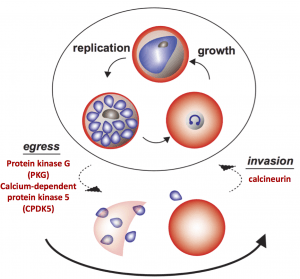 Molecular analysis of Plasmodium invasion of red blood cells: ligand-receptor interactions and signal transduction
Molecular analysis of Plasmodium invasion of red blood cells: ligand-receptor interactions and signal transduction
A major focus of our laboratory has been the elucidation of the mechanism by which Plasmodium parasites invade host red blood cells (RBCs), within which they proliferate or become transmissible sexual forms. Invasion occurs via a complex mechanism, with many features unique to apicomplexan parasites, beginning with attachment to the host RBCs, followed by the formation of a tight junction, active entry into the RBC and resolution of the parasitophorous vacuole (PV). Entry involves multiple and specific ligand-receptor interactions, which are known as invasion pathways. The merozoite surface is directly exposed to host immunity making invasion ligands potential candidates for vaccine development.
We are working to identify specific ligand-receptor interactions in different Plasmodium spp. to inform vaccine development and to understand the biological implications of the use of alternative ligand-receptor pairs, known as invasion pathways.
Papers of Interest:
The Molecular Basis of Erythrocyte Invasion by Malaria Parasites. (Review)
Cowman AF, Tonkin CJ, Tham WH, Duraisingh MT. Cell Host Microbe. 2017 Aug 9;22(2):232-245.
Parasite Calcineurin Regulates Host Cell Recognition and Attachment by Apicomplexans.
Paul AS, Saha S, Engelberg K, Jiang RH, Coleman BI, Kosber AL, Chen CT, Ganter M, Espy N, Gilberger TW, Gubbels MJ, Duraisingh MT. Cell Host Microbe. 2015 Jul 8;18(1):49-60.
